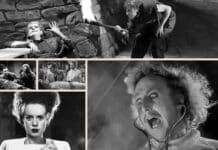DR KAJA FRANCK marks International Women’s Day by looking at great female writer Mary Shelley’s Frankenstein, still politically relevant 200 years on…
In my previous post for Spooky Isles, I concentrated on the creation of John Polidori’s The Vampyre (1819).
For International Women’s Day, I am turning to text which eclipsed this vampiric novella, Mary Shelley’s Frankenstein (1818) which is turning 200 this year.
The impact of Frankenstein on popular culture cannot be understated.
The Monster finds itself in the company of archetypal creatures such as the vampire, werewolf and the zombie.
Indeed, elements of Frankenstein’s monster can be seen in the modern zombie, brought to non-life by George A. Romero: the shambolic movements, the uncanny grotesqueness of the Undead and, increasingly, the sense that science is culpable in bringing about the end of humanity.
Thus, Shelley’s novel has also been seen as birthing a whole new genre, Science Fiction.
The narrative’s depiction of the medical student, isolated in his lab, being drawn into increasingly nefarious behaviour, replaces the dark arts of magic with those of science.
The supposed rationality of the scientific revolution is undermined through Shelley’s words as she shows that any pursuit, no matter how honourable, can be undermined through egotistical single-mindedness.
The immediate story regarding the inception of Shelley’s most famous work is well-known.
However, to understand the genesis of one of the most famous monsters, it is worth digging deeper into Shelley’s background.
Born Mary Wollstonecraft Godwin in August 1797, her parents were the political philosopher William Godwin and proto-feminist philosopher Mary Wollstonecraft, who wrote A Vindication of the Rights of Women (1792).
Her mother died soon after her death and she received a liberal education in which she was encouraged to read her mother’s works.
She started her relationship with Romantic poet Percy Bysshe Shelley in 1814, at the age of 17. Percy and Mary travelled Europe, before returning to England, with Mary pregnant with their first child.
They were ostracised by their community and their daughter died, having been born prematurely. The couple did not marry until late in 1816, following the suicide of Harriet, Percy’s first wife. It was during the summer of 1816 that the two travelled to the Villa Diodati, where Mary would have the nightmare which led to the creation of Frankenstein.
There is an internet meme that states, though with some variation that: ‘Knowledge is knowing that Frankenstein is not the monster. Wisdom is knowing that Frankenstein is the monster’.
In light of the recent articles by both The Times and The Sun, this comment seems more pertinent than ever.
Central to Shelley’s story is the notion of human rights and whether monsters are birthed or created: is the violence of the Monsters inevitable?
By decentralising the power of God in the conception of life, and thus removing its inherent sanctity, Frankenstein’s creation is, at first, more automaton than person.
The reader is forced to analyse difficult, if not impossible, questions regarding to whom we extend personhood and, concomitantly, human rights.
But the novel also asks us about our responsibilities to other people. Frankenstein neglects his duties as a father-like figure. (Following the death of Shelley’s daughter, this is particularly poignant).
He believes his job is simply to provide the spark of life without taking responsibility for his offspring.
It is this immediate neglect which builds the foundations for the Monster’s later violence.
There are, however, opportunities throughout the narrative for other people to show compassion to the Monster and, in doing so, prevent his descent into madness.
It is repeatedly being rejected for what he appears to be that forces him to fully embody the label ‘monster’ – a salutary lesson for all readers in how they treat those around them.
Such a reading allows us to realise the importance of compassion in stopping the mindless creation of more monsters.
The power of Frankenstein goes beyond its ability to scare the reader: it forces us to analyse what makes us scared and how monsters come into existence. In doing so, Shelley creates a politically-charged novel that remains provocative even 200 years later.









